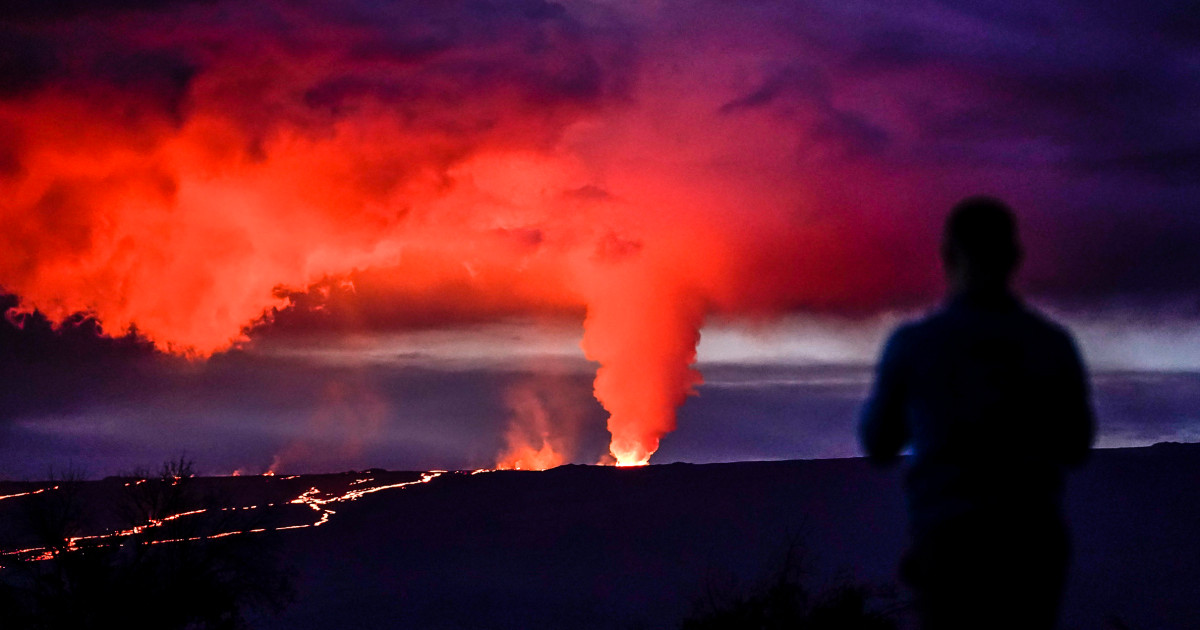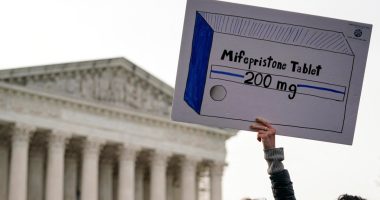
When Hawaii’s Mauna Loa, the world’s largest active volcano, erupted this week for the first time in almost four decades, it wasn’t just a major geological event. For many in the Native Hawaiian community, it carried a larger cultural and political symbolism and a message to respect Indigenous communities and land.
The eruption, which began late Sunday, coincided Monday with Hawaiian Independence Day, known as Lā Kūʻokoʻa, which commemorates the formal international recognition of the Kingdom of Hawaii’s sovereignty almost two centuries ago. Many Native Hawaiians are drawing from their mythology around Pele, the Hawaiian goddess of fire and creator of the islands, to help assign meaning to the historic eruption.
Against the backdrop of a Hawaii that continues to contend with the consequences of U.S. colonization, many Native Hawaiians say the auspicious timing of the eruption is no coincidence, but a “reaffirmation” of the community’s cultural practices and independence, and a rejection of colonial forces on their land.
“The Native people have been saying this isn’t your place to extract and profit from anymore,” said Kaniela Ing, co-founder of Native Hawaiian-focused organization Our Hawaii and a former state legislator. “You don’t have authority to shape our sacred lands.”
The eruption, Ing said, “is Pelehonuamea saying, ‘They’re right. My people are right.’”
The deity Pele, often referred to as “Tūtū Pele,” or grandmother Pele, has been regarded as an ancestor who “creates new land” as hardened, molten lava adds to the surrounding terrain.
— ku’ualoha ho’omanawanui, author of “Voices of Fire: Reweaving the Literary Lei of Pele and Hi’iaka.”
Mauna Loa, on the island of Hawai’i and alongside the dormant, snowcapped volcano Mauna Kea, is expected to continue erupting for weeks. Thus far, the lava flow has significantly slowed and does not pose a threat to communities, the Hawaii Emergency Management Agency said. However, authorities expect it to eventually reach Daniel K. Inouye Highway, which is less than four miles away, in roughly a week or more.
The fiery red magma rupturing from the earth’s crust is profound when examined through the lens of Hawaiian mythology, ku’ualoha ho’omanawanui, a Native Hawaiian scholar and the author of “Voices of Fire: Reweaving the Literary Lei of Pele and Hi’iaka,” told NBC News.
While the lore of Pele has often been commodified for tourists, sometimes cast as a vengeful god who punishes those who snag lava rocks as a souvenir, ho’omanawanui (who lower cases her name) explained that the deity, often referred to as “Tūtū Pele,” or grandmother Pele, has also been regarded as an ancestor who “creates new land” as hardened, molten lava adds to the surrounding terrain. And Pele’s lava flow, ho’omanawanui said, is associated with a cleansing that the Native Hawaiian community receives with gratitude rather than fear.
“It has really cultivated a sense of awe and really what we feel today … is just a tremendous sense that the Earth is alive,” ho’omanawanui said. “We’re seeing new land, new geographical features being born right in front of our eyes, and there is no power — no human power — that can stop it or can deter it.”
Many in the community have seen this as Pele’s warning to the armed forces, whose presence in the area has made the islands the most densely militarized state in the country, according to research published in Pacific Public Health.
Pele’s symbolism is particularly significant in the context of Hawaiian Independence Day, marked by the signing of the Anglo-Franco Proclamation of 1843. Experts note that 50 years after the proclamation, the U.S. illegally overthrew the Kingdom of Hawaii and became a colonial presence on the islands.
One particularly controversial arm of American colonialism has been the military occupation on the islands. And Sharde Freitas, a Native Hawaiian cultural practitioner, advocate and member of the Aloha ʻĀina Legal Group, explained that the lava flow has been heading toward the Pohakuloa Training Area, a military training ground. Many in the community have seen this as Pele’s warning to the armed forces, whose presence in the area has made the islands the most densely militarized state in the nation, according to research published in Pacific Public Health. Pohakuloa in particular, Freitas said, has been an active source of debate in recent years as its lease is set to expire in 2029, and many have protested its renewal.
Similarly, ho’omanawanui said that there have been a variety of offenses, ranging from cultural to environmental consequences, caused by the military occupation. Most recently, 1,100 gallons of toxic fire-suppressing foam leaked from Red Hill fuel storage facility, operated by the U.S. Navy. The leak follows another major spill from the same facility last year that sickened families who relied on a nearby well for water.
“This is just a reminder of … at any point, nature can reclaim everything that colonial society deems as wealth.”
— Kaniela Ing, Our Hawaii
“The occupation of land for military use has resulted in the destruction of the natural environment, the release of dangerous toxins, the destruction of people’s homes, and the displacement of people,” the report said.
The lava flow toward Pohakuloa is a sign, ho’omanawanui said.
“Something’s saying, ‘Hey, U.S. military, we’ve been saying for a very long time that you shouldn’t be here and you shouldn’t be doing this,’” she said. “We’ve had all of these, in essence, warnings along the way. We’ve had lessons that have been taught, and yet the military still continues to ignore. So now Pele is coming in.”
The symbolism around the eruption can also be applied to another lasting colonial force on the island: the tourism industry, Ing said. The industry has led to the displacement of Native Hawaiians due to rising housing costs, and their forced migration and assimilation in other areas in the U.S.
“Tourism only works when we’re poor. And the people who work here and build the place are poorer than the people who play here,” Ing said.
Source: | This article originally belongs to Nbcnews.com










